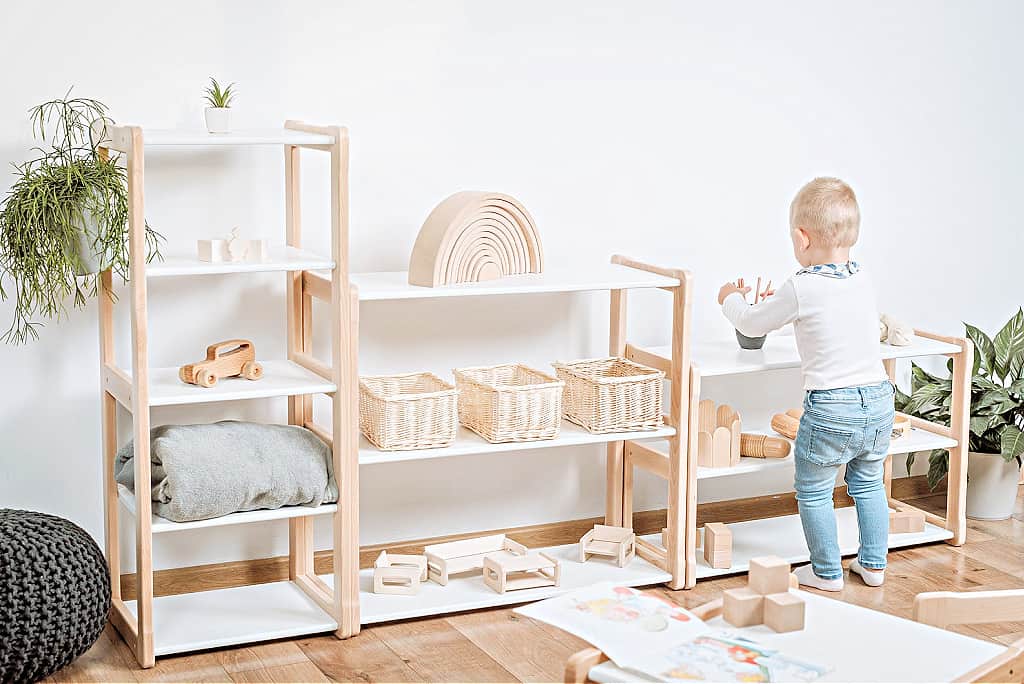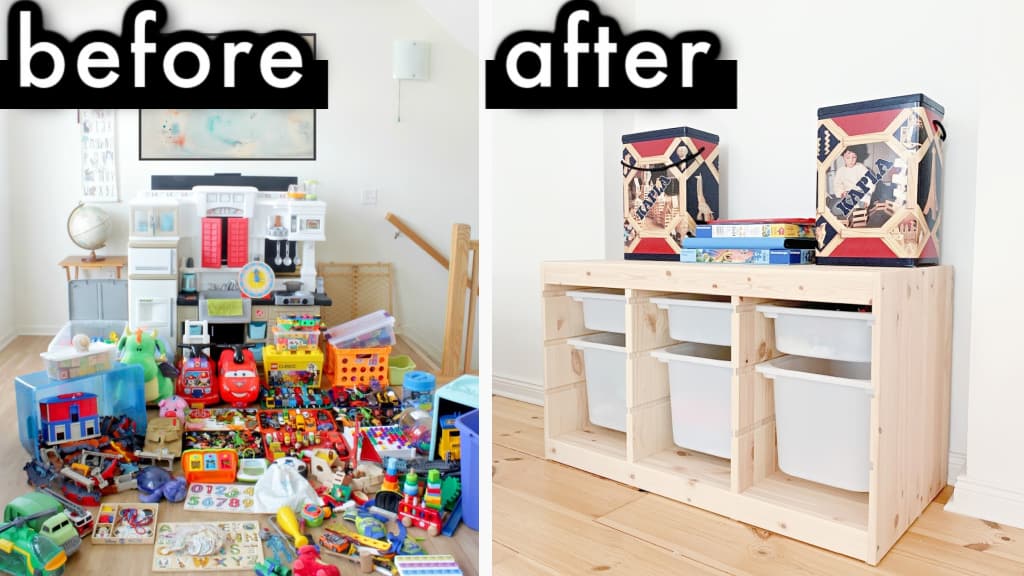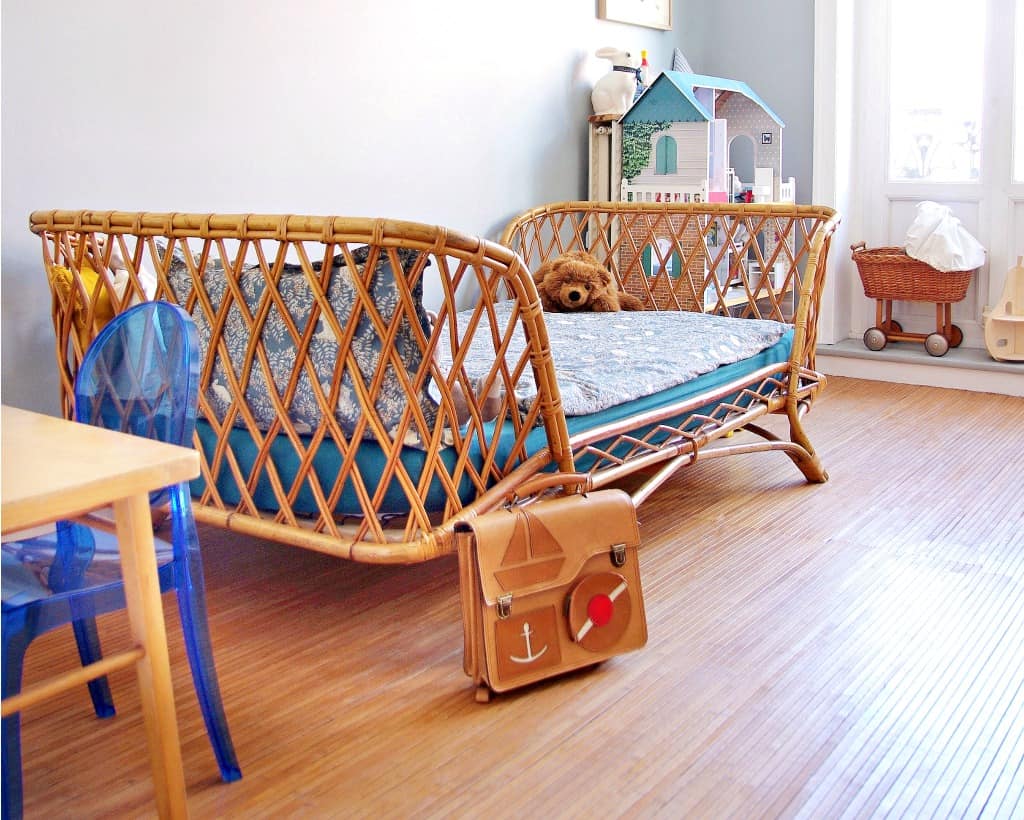10 Minimalism with Kids Tips That Can Save Your Motherhood
This post may contain affiliate links for your convenience. That means that if you make a purchase, I will receive a small commission at no extra cost to you. Read more here.
If you have landed here, you are probably fed up to your eyebrows with kids and toy clutter and ready to embrace minimalism – but you are doubting yourself and questioning, “Is minimalism with kids really possible?”
Yes, hi there, hello, welcome to my world!
As a former hoarder turned minimalist mom of two very active boys, I’m here to tell you that minimalism with kids is possible and can literally save your motherhood.
Starting this family minimalism journey five years ago was hands down the BEST thing I’ve ever done for my family and, to be honest, myself.
Because, let’s face it, moms tend to put their families first and themselves dead last.
You can feel good about becoming a minimalist with kids because there are so many benefits of living minimally that are backed by science, including:
- a healthier body and marriage
- smarter, happier, and more creative children
- more freedom to enjoy the things you enjoy
- less time spent cleaning and tidying up
- more money
- and more…
Let’s explore all the ways living minimally can make your life better and how to get started today!
READ MORE: 10 Surprising Benefits of Minimalism That Experts Say Are TRUE!

Can you be a minimalist with kids?
Yes, yes, YES – minimalism with kids is possible!
Banish all doubt from your mind.
Before I discovered minimalism, I was an emotional hoarder, carrying around years of clutter left behind by the deaths of my parents, grandparents, and many loved ones.
I had trouble letting go of the past and lived surrounded by gobs and gobs of my own clutter, and then we added kids to the mix.
Which is pretty much like throwing gasoline on a bonfire — BOOM!
I remember watching my kids walk around, pick up a box of toys and dump it onto the floor, not touch ONE SINGLE TOY, and move right on to repeat the process with the next bin.
Now that we are past that as a family, I can laugh about it, but it drove me crazy at the time.
In the middle of my five-year minimalism journey, I remember finding a half-eaten quesadilla and a squadron of carrots inside a toy car. I wish I had known about minimalism before I started my baby registry – it would have made my years as a new mom much less stressful!

What is minimalism?
Unfortunately, the stories about minimalism that hit the news tend to be extreme and result in confusion about what minimalism really is.
Perhaps it’s better to think about what minimalism isn’t.
- Minimalism has nothing to do with how many clothes you have in your wardrobe or what kind of car you drive
- Being a minimalist doesn’t mean you need to live in a tiny house or paint all of your walls white
- Minimalism isn’t about getting rid of everything you own.
- It doesn’t mean you don’t spend money anymore
- Most of all, being a minimalist doesn’t mean giving up activities and items you love!
One of my favorite quotes about the definition of minimalism is the one below:
Joshua Becker has written five bestselling books on minimalism, so it’s definitely worth listening to what he has to say.
Minimalism is the intentional promotion of the things we most value and the removal of anything that distracts us from it.
Joshua Becker

Take it from a guy who has two young children himself and literally wrote the book on being “Clutterfree with Kids”, minimalism with kids IS possible! (CLICK HERE TO CHECK PRICE ON AMAZON
10 Minimalism with Kids Ideas
Getting kids on board with minimalism might not be easy, but it is very rewarding in the long run.
1. Gently introduce minimalism to your children
Children are inquisitive little creatures with a lot of curiosity, and first impressions matter a lot in their small and safe worlds.
Introduce minimalism to your kids slowly and allow them to be curious about minimalism and what it means. Encourage them to ask questions.
I love Marie Kondo, so as a family, we watched a few Tidying Up with Marie Kondo on Netflix; my kids loved seeing the episodes with other young children helping with the tidying up.
TBH, it’s one of the reasons my youngest son now has such a passion for folding clothes and blankets. 😂
Minimalism books for kids
Here are a few books about minimalism for kids, in case they are in need a little more visual encouragement and hand-holding.
Or you can see if one of these 30 popular minimalism blogs resonates with you – trust you, there’s SOMETHING out there that will stick!

From the tidying fairy herself, Marie Kondo, a story about the power of friendship and recognizing what brings joy to your life.

This cute little book is great because it shows real images of children tidying up all over the world, from Moscow to Indonesia! This book goes in and out of stock on Amazon, so you can also look for it secondhand (here it is on eBay) or at your local library.

What kid wouldn’t empathize with Cami, whose room has become so cluttered she can’t find the thing she desperately needs to return to her friend! This book has a 4.9/5 star rating from parents and kids alike!
2. Be a good leader; start with your clutter
Smart moms know the best to get children to follow is to lead. How can you ask your kids to declutter their toys and clothes if you haven’t done so yourself?
Start your decluttering projects in your personal spaces and invite your kids to join you.
Remember to emphasize the core values of minimalism to encourage good habits in the future. Focusing on finding more time for what matters to you as a family as you mindfully clear your space.
Read More: 10 Minimalist Mom YouTube Channels to Follow for REAL Help!
3. Encourage everyone to participate
Yes, that means everyone — husbands too!
Teach each member of the family to take ownership of their own possessions.
That means decluttering their own things and maintaining them after they have been tidied.
If something is taken out, it should be returned to its proper place by the taker-outer.
4. Positive reinforcement can help good habits “stick”
Never, ever, under any circumstances, threaten to declutter your child’s things as a form of “punishment”.
Emphasize the positive points of decluttering, such as the fact that by donating their clutter they are not only making someone else happy but also giving the toys a new chance.
Praise them for their efforts and make sure to point out how much more time you have to do activities they enjoy.
If you give positive reinforcement like praise and more time spent together having fun, then the good habits will be more likely to stick in the future.
5. Start by sorting their favorites
As Marie Kondo says in her revolutionary book, The Life-Changing Magic of Tidying Up:
We should be choosing what we want to keep, not what we want to get rid of.
Marie Kondo
When you are ready to start decluttering, have boxes and bins ready for sorting. This helps streamline the process and make decluttering faster and easier for everyone. (Read more about the do’s and don’ts of the KonMari Method here.)
Label your boxes:
- keep
- sell
- donate
- recycle
Now, make let’s make everything simple by starting with their favorites.
Have your kids start by pulling out their absolute favorite toys, the ones they adore and play with every day – if they are very young, you can help guide them in this.
These beloved items act as a compass, pointing their decisions in the right direction so they can identify what they need, use, and love in their daily lives.
After they have saved the favorites, it’s easier to sort through the leftover stuff. Clothes that are too worn or too small, toys that are broken and haven’t been played with for years, and other flotsam and jetsam just taking up space.
READ MORE: We got rid of 95% of our stuff and moved to Europe! Here is an entire blog post on decluttering journey.
6. Do daily clean-ups & seasonal declutters
After you’ve completed a “big” declutter, then all you have to do is practice good habits that will help your family remain clutter-free with kids.
At the end of each day, we like to spend 30 minutes or so tidying up toys, books, and any other things that might have found their way onto the floor, then after the kids have gone to bed, I do a quick kitchen wipedown, and my husband and I can relax together.
Then, at the end of one season and the beginning of the next, we complete a small decluttering session. This is easy since we own so few things!
We look at what clothing items we have outgrown or worn out, toys that have been broken or no longer age-appropriate, and other seasonal decluttering tasks.
It’s so much more relaxing to declutter when you are a minimalist family!
7. Set clear boundaries
After you have finished decluttering, keep activities, books, and toys contained in a single location. This helps keep toy clutter localized to one area and makes it easier to clean up afterward!
Depending on the age of your children and the layout of your home, however, this may or may not be practical — safety and comfort come first!
My boys keep their toys in their bedroom but are allowed to bring them out into our living room to play with, provided they clean them up at the end of the day.
If your kids do bring toys or stuffed animals out to play with, make sure they know they are responsible for returning them to their proper place afterward.
8. Corral clutter with bins
Prevent future clutter from creeping out by using pretty boxes, bins, or baskets to stash their toys – choose sturdier storage bins so your kids can easily clean up after themselves!
When he was still a toddler, my oldest attended a Montessori school in Chicago, and that was the most beautiful and well-kept playroom I have ever seen.
The bright white and natural wood of Montessori shelving is perfectly suited to a minimalist aesthetic playroom.
The beautiful thing about being a minimalist is that less is more – you don’t need that much home decor, just highlight the stuff you love, and that makes you happy!

9. Start a memory box for school art & souvenirs
Sure, as a mother you treasure these precious moments with your children and want to remember them, but realistically they don’t need to keep everything.
We started an art portfolio and recently created our own DIY memory boxes – we turned it into a fun family project that also became a special memory!
Set emotional boundaries and make sure you don’t go overboard – a good rule of thumb is to ask if they will still want to look at that item in 20 years and if it’s worth storing for that long.
Thanks for keeping every scrap of paper I ever owned, Mom.
Sincerely, NO CHILD EVER
READ MORE: 10 Memory Box Ideas That Are PERFECT to Store Your Keepsakes
10. Practice mindful shopping as a family
If you don’t change the habits that led you to accumulate clutter in the first place, your child’s clothing and toys will go right back to being messy and you don’t want that, right?
Even the most minimal minimalist will find they need to buy new things at some point in their life.
Especially if you have children – after all, they do that pesky thing called growing up (how dare they). 😉
Going forward, make a commitment to shop mindfully and be aware of the responsibility of your purchases. Ask them and yourself, “Is this something we really need?” and “What place does this thing have in my home and my life?”
Even when you go to buy gifts for birthdays or Christmas, you can still be intentional and mindful with your spending.
Here are a few posts that can help you with this.
- 37 Non-Toy Gifts for Kids to Ignite Their Inner Genius and Creativity
- 50+ Experience Gifts for Kids (for Memories That LAST)
Are you ready to get started on your minimalist journey?
Sign up in the box below to grab your FREE 10-page decluttering checklist to help you out.


This is all well and good as long as you don’t have other people buying massive amounts of toys (ie grandma). How do you preserve relationships with people like this who buy way too much way too often but also get them to scale back?
As someone who has family whose love language is “gift-giving”, I understand this is a touchy subject! For some people, that’s just their preferred method to express love. However, some things you can do include: actually HAVING a discussion about gifts (as early as possible after having kids), gently suggesting alternatives like trips to the zoo together, experiences, or consumables, etc. However, at the end of the day, you have the final say as to what you keep in your home! I hope this helps.